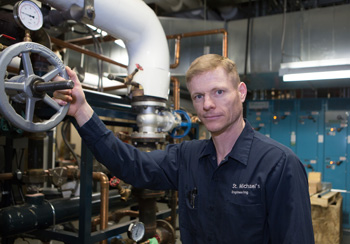How planned shutdowns keep the hospital running

By Kate Manicom

Steven Trentin, a lead plumber, prepares a heat exchanger for a shutdown. The device uses steam to heat water, which is then pumped throughout the facility to heat the hospital. (Photo by Katie Cooper)
Hidden behind the walls and above the ceilings at St. Michael’s are the systems essential to providing patient care, powering lights on the helipad, transferring steam to sterilize equipment and pumping medical gas to the ICUs.
Both regular hospital maintenance and construction require planned shutdowns of hospital systems. When service is added or eliminated, like connecting power to a renovated clinic or removing obsolete pipes, the electricity must be turned off or pipes fully drained to safely do work. The Engineering and Plant Services Department has completed more than 500 shutdowns specifically for the 3.0 construction and renovation project since it started two years ago.
“A shutdown is not just a quick flip of a switch; each one is unique,” said Quinton D’Mello, manager of Engineering and Plant Services. “The type of service affected, the wing of the hospital, even the weather, are all factors in the timing and duration of a shutdown. They require planning, coordination and communication. But the number one priority is ensuring patient care is unaffected.”
After receiving a shutdown request from the contractor, the Engineering team reviews the hospital’s as-built drawings to understand the impact of the shutdown. As-built drawings show all the changes that have been made to a building’s systems since it was constructed. Due to the age of some parts of the hospital, plumbing as-built drawings are sometimes unreliable because of the condition of the drawings or because they don’t reflect small changes made over the years.
“A shutdown is not just a quick flip of a switch; each one is unique.” – Quinton D’Mello, manager of Engineering and Plant Services |
When the full impact of a shutdown can’t be determined by drawings, Engineering investigates in person, opening walls or ceilings to see how the services have been laid out. This work is done in consultation with Infection Prevention and Control and the affected unit.
Shutdowns are often completed at night, when reduced water supply or changes in temperature will be less likely to affect patient care. No matter the hour, the Engineering team is on site to monitor. A plumbing shutdown may require a fire watch if water is cut to sprinklers. Shutdowns affecting sterile areas need to be closely observed to ensure humidity and temperature levels do not exceed levels where bacteria can grow.
Communication between all parties is key, said D’Mello. Staff in affected areas must feel prepared and understand the scope of work. The Engineering team must also be in close contact with the contractor to know when the work will start, end or if problems arise in the midst of the shutdown.
“Shutdowns take time, both to prepare and to execute,” said D’Mello. “But ideally when a shutdown goes well, no one will notice it.”
About St. Michael’s Hospital
St. Michael’s Hospital provides compassionate care to all who enter its doors. The hospital also provides outstanding medical education to future health care professionals in more than 29 academic disciplines. Critical care and trauma, heart disease, neurosurgery, diabetes, cancer care, and care of the homeless are among the Hospital’s recognized areas of expertise. Through the Keenan Research Centre and the Li Ka Shing International Healthcare Education Center, which make up the Li Ka Shing Knowledge Institute, research and education at St. Michael’s Hospital are recognized and make an impact around the world. Founded in 1892, the hospital is fully affiliated with the University of Toronto.
